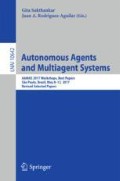Abstract
Connected and autonomous vehicle technology has advanced rapidly in recent years. These technologies create possibilities for highly efficient, AI-based, transportation systems. One such system is the Autonomous Intersection Management (AIM), an intersection management protocol designed for the time when all vehicles are fully autonomous and connected. Experts, however, anticipate a long transition period during which human and autonomously operated vehicles will coexist. Unfortunately, AIM has been shown to provide little or no improvement over today’s traffic signals when less than 90% of the vehicles are autonomous, making AIM ineffective for a large portion of the transition period. This paper introduces a new protocol denoted Hybrid Autonomous Intersection Management (H-AIM), that is applicable as long as AIM is applicable and the infrastructure is able to sense approaching vehicles. Our experiments show that this protocol can decrease traffic delay for autonomous vehicles even at 1% technology penetration rate.
Access this chapter
Tax calculation will be finalised at checkout
Purchases are for personal use only
Notes
- 1.
This paper assumes driving on the right side of the road. However, the ideas can trivially be generalized to a left side driving policy.
- 2.
Dresner and Stone [5] do not report the turning ratios for their mixed traffic experiment. Our turning ratio was chosen since it results in a good balance between the incoming queues when 100% of the vehicles are HV.
References
Abu-Lebdeh, G., Benekohal, R.: Development of traffic control and queue management procedures for oversaturated arterials. Transp. Res. Record J. Transp. Res. Board 1603, 119–127 (1997)
Au, T.-C., Zhang, S., Stone, S.: Autonomous Intersection Management for semi-autonomous vehicles. In: Handbook of Transportation. Taylor & Francis Group, Routledge (2015)
Bansal, P., Kockelman, K.M.: Forecasting Americans’ long-term adoption of connected and autonomous vehicle technologies. In: Transportation Research Board 95th Annual Meeting, no. 16–1871 (2016)
Coifman, B., Beymer, D., McLauchlan, P., Malik, J.: A real-time computer vision system for vehicle tracking and traffic surveillance. Transp. Res. Part C Emerging Technol. 6(4), 271–288 (1998)
Dresner, K., Stone, P.: A multiagent approach to Autonomous Intersection Management. J. Artif. Intell. Res. 31, 591–656 (2008)
Fajardo, D., Au, T.-C., Waller, S., Stone, P., Yang, D.: Automated intersection control: Performance of future innovation versus current traffic signal control. Transp. Res. Record J. Transp. Res. Board 2259, 223–232 (2011)
Furda, A., Vlacic, L.: Enabling safe autonomous driving in real-world city traffic using multiple criteria decision making. IEEE Intell. Transp. Syst. Mag. 3(1), 4–17 (2011)
Gajda, J., Sroka, R., Stencel, M., Wajda, A., Zeglen, T.: A vehicle classification based on inductive loop detectors. In: Proceedings of the 18th IEEE Instrumentation and Measurement Technology Conference, IMTC 2001, vol. 1, pp. 460–464. IEEE (2001)
Hasch, J., Topak, E., Schnabel, R., Zwick, T., Weigel, R., Waldschmidt, C.: Millimeter-wave technology for automotive radar sensors in the 77 GHz frequency band. IEEE Trans. Microw. Theory Tech. 60(3), 845–860 (2012)
Liu, Y., Chang, G.-L.: An arterial signal optimization model for intersections experiencing queue spillback and lane blockage. Transp. Res. Part C Emerg. Technol. 19(1), 130–144 (2011)
Regele, R.: Using ontology-based traffic models for more efficient decision making of autonomous vehicles. In: Fourth International Conference on Autonomic and Autonomous Systems (ICAS 2008), pp. 94–99. IEEE (2008)
Acknowledgments
A portion of this work has taken place in the Learning Agents Research Group (LARG) at UT Austin. LARG research is supported in part by NSF (CNS-1330072, CNS-1305287, IIS-1637736, IIS-1651089), ONR (21C184-01), AFOSR (FA9550-14-1-0087), Raytheon, Toyota, AT&T, and Lockheed Martin. The authors would also like to thank the Texas Department of Transportation for supporting this research under project 0-6838, Bringing Smart Transport to Texans: Ensuring the Benefits of a Connected and Autonomous Transport System in Texas. Peter Stone serves on the Board of Directors of, Cogitai, Inc. The terms of this arrangement have been reviewed and approved by the University of Texas at Austin in accordance with its policy on objectivity in research.
Author information
Authors and Affiliations
Corresponding authors
Editor information
Editors and Affiliations
Rights and permissions
Copyright information
© 2017 Springer International Publishing AG
About this paper
Cite this paper
Sharon, G., Stone, P. (2017). A Protocol for Mixed Autonomous and Human-Operated Vehicles at Intersections. In: Sukthankar, G., Rodriguez-Aguilar, J. (eds) Autonomous Agents and Multiagent Systems. AAMAS 2017. Lecture Notes in Computer Science(), vol 10642. Springer, Cham. https://doi.org/10.1007/978-3-319-71682-4_10
Download citation
DOI: https://doi.org/10.1007/978-3-319-71682-4_10
Published:
Publisher Name: Springer, Cham
Print ISBN: 978-3-319-71681-7
Online ISBN: 978-3-319-71682-4
eBook Packages: Computer ScienceComputer Science (R0)

